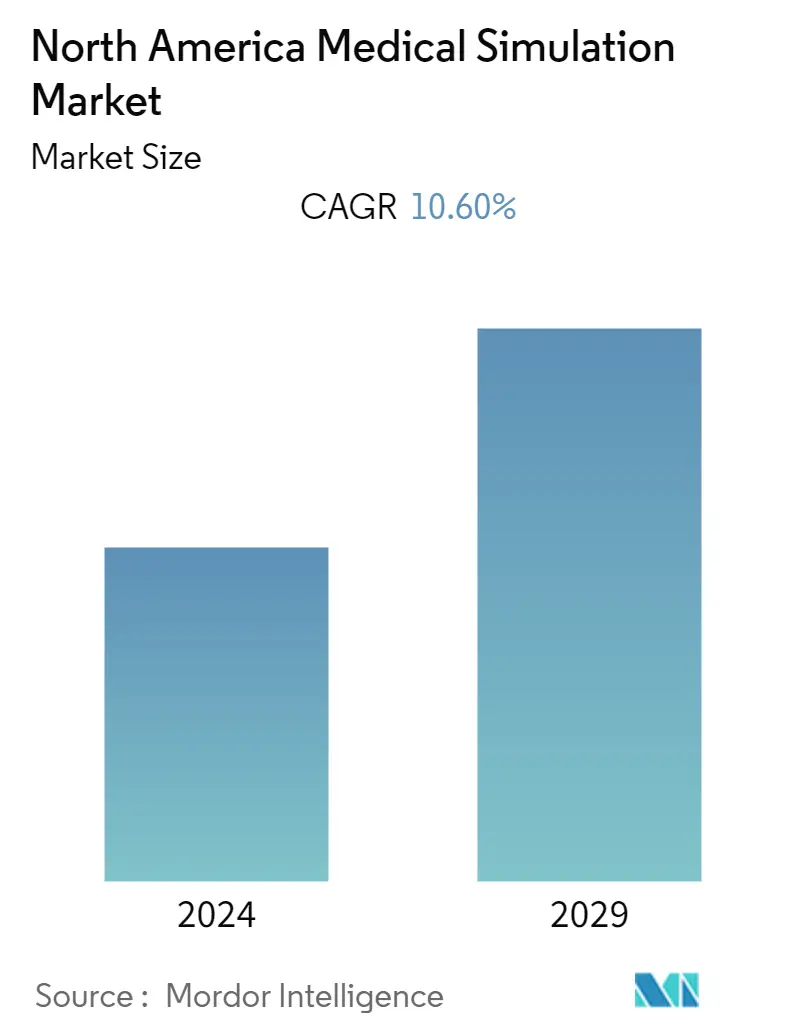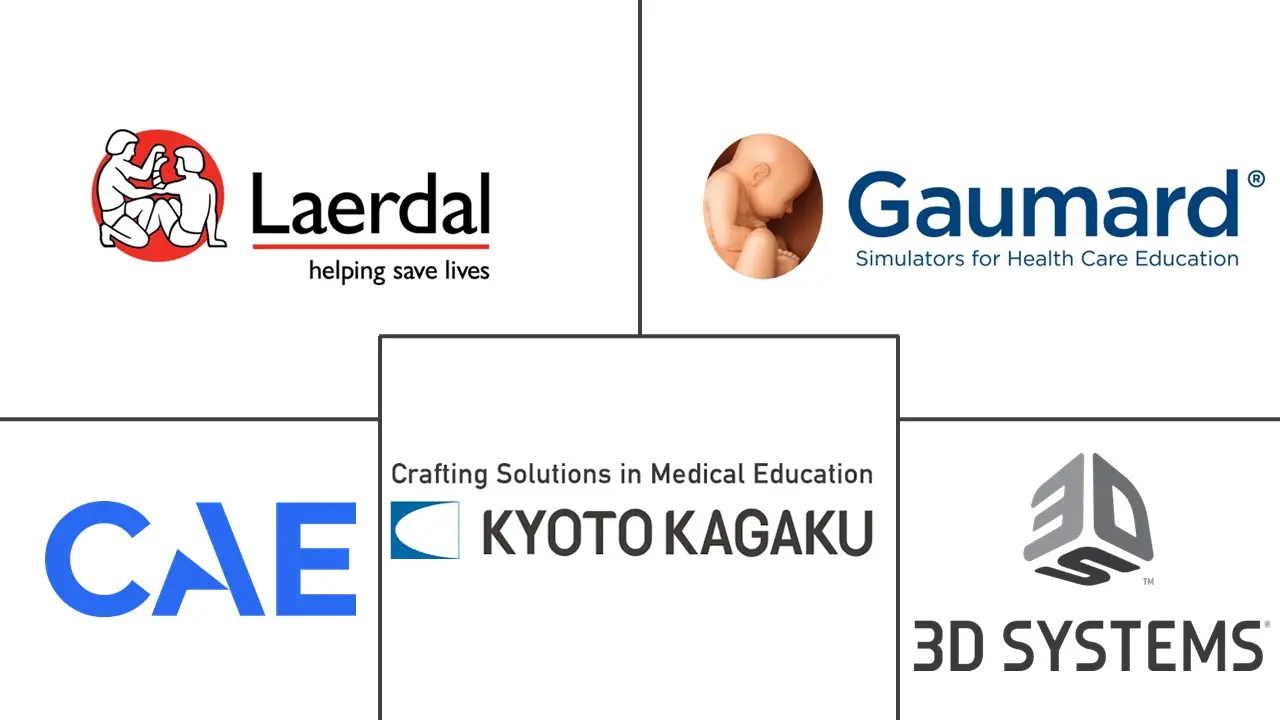| Study Period | 2021 - 2029 |
| Base Year For Estimation | 2023 |
| Forecast Data Period | 2024 - 2029 |
| Historical Data Period | 2021 - 2022 |
| CAGR | 10.60 % |
Major Players*Disclaimer: Major Players sorted in no particular order |
North America Medical Simulation Market Analysis
The North American medical simulation model is expected to register a CAGR of 10.6% over the forecast period.
The COVID-19 pandemic had affected several parts of the healthcare sector. With the onset of COVID-19, several countries embraced digital healthcare to a notable extent to share data regarding infection status. For instance, an article titled 'Overcoming COVID-19 Challenges: Using Remote and Hybrid Simulation Designs in DNP Programs' published in March 2022 by a group of researchers at the Edson College of Nursing and Health Innovation, United States indicated that there was a transition from a predominately in-person design to fully online medical simulation during the COVID-19 pandemic. The restrictions imposed by the governments on the movement of people had notably impacted the training for healthcare professionals, which helped the development of medical simulation models during the pandemic period, thus aiding in the market growth. However, in recent times using simulation and technology-enhanced learning to negotiate and adapt to recurring difficulties in healthcare education the studied market is expected to grow over the forecast period.
The requirement for medical simulation in minimally-invasive surgery has been established over the past few years. In minimally-invasive surgery (MIS), doctors use various methods to operate with minimal damage to the body as opposed to traditional open surgery. Traditional open surgeries involve long incisions that should be made through the muscles, which take considerable time to heal. MIS procedures, however, involve smaller incisions, leading to a quicker recovery. Several medical institutions have fellowship programs that boost the minimally invasive procedure. For instance, in November 2021, McGill University announced the McGill Minimally Invasive Surgery Fellowship for a duration of one year supported by the Steinberg Bernstein Centre for Minimally Invasive Surgery and Innovation and the Montreal General Hospital Foundation. Similarly, in September 2021, the University of Manitoba offered the Minimally Invasive and Bariatric Surgery (MIS) Fellowship for a duration of one year. Such activities are likely to boost the growth of the medical simulation market over the forecast period.
Moreover, technological advancement in the medical field and the launch of the advanced product is expected to boost the market. For instance, in January 2022, Inovus Medical launched a new high-fidelity hysteroscopy simulator, HystAR, which combines augmented reality technology and a cloud-based learning platform with the natural haptics of its simulated tissue models to deliver highly realistic, scalable, tracked hysteroscopy skills training. Thus, with the increasing number of minimally-invasive procedures, the demand for medical simulators is likely to increase in the region. However, the high cost of stimulators may restrain the market over the forecast period.
North America Medical Simulation Industry Segmentation
As per the scope of the report, medical simulation is the modern-day methodology for training healthcare professionals through the use of advanced educational technology. Medical simulation is experiential learning that every healthcare professional may need, but cannot be always engaged in during real-life patient care. The market for medical simulation is growing with increasing healthcare facilities. The North America Medical Simulation Market is Segmented by Product and Services (Products (Interventional/Surgical Simulators (Laparoscopic Surgical Simulators, Gynecology Surgical Simulators, Cardiac Surgical Simulators, Arthroscopic Surgical Simulators, and Other Products), Task Trainers, Other Products and Services), Services and Software (Web-based Simulation, Medical Simulation Software, Simulation Training Services, and Other Services and Software)), Technology (High-fidelity, Medium-fidelity, and Low-fidelity Simulators), End User (Academic and Research Institutes and Hospitals), and Geography (United States, Canada, and Mexico). The report offers the value (in USD million) for the above segments.
| Products | Interventional/Surgical Simulators | Laparoscopic Surgical Simulators |
| Gynecology Surgical Simulators | ||
| Cardiac Surgical Simulators | ||
| Arthroscopic Surgical Simulators | ||
| Other Products | ||
| Task Trainers | ||
| Other Products and Services | ||
| Services and Software | Web-based Simulation | |
| Medical Simulation Software | ||
| Simulation Training Services | ||
| Other Services and Software |
| High-fidelity Simulators |
| Medium-fidelity Simulators |
| Low-fidelity Simulators |
| Academic and Research Institutes |
| Hospitals |
| North America | United States |
| Canada | |
| Mexico |
North America Medical Simulation Market Size Summary
The North American medical simulation market is poised for significant growth, driven by advancements in technology and the increasing adoption of minimally invasive surgical procedures. The COVID-19 pandemic accelerated the shift towards digital healthcare solutions, including remote and hybrid medical simulations, which have become integral in training healthcare professionals. This transition has underscored the importance of simulation in healthcare education, contributing to the market's expansion. The demand for high-fidelity simulators, which offer realistic training environments, is on the rise, particularly in nursing education and acute care settings. These simulators are essential for training healthcare providers in emergency response and complex medical procedures, further propelling market growth.
The market is characterized by a high level of fragmentation, with numerous players offering innovative products and solutions. Key companies such as 3D Systems, Canadian Aviation Electronics (CAE) Inc., and Laerdal Medical are at the forefront, introducing advanced simulation technologies and fostering partnerships to enhance training capabilities. The United States is expected to dominate the market due to its robust healthcare infrastructure, technological advancements, and the presence of major industry players. The increasing acceptance of minimally invasive surgeries, supported by simulation training, is anticipated to drive demand for medical simulators. However, the high cost of these simulators may pose challenges to market growth. Overall, the North American medical simulation market is set to experience substantial growth, supported by technological innovations and the evolving needs of healthcare education and training.
North America Medical Simulation Market Size - Table of Contents
1. MARKET DYNAMICS
- 1.1 Market Overview
-
1.2 Market Drivers
- 1.2.1 Increasing Demand for Minimally-invasive Treatments
- 1.2.2 Technological Advancements in Medical Field
- 1.2.3 Benefits of Simulation Over Traditional Learning
-
1.3 Market Restraints
- 1.3.1 High Cost of Simulators
- 1.3.2 Reluctance to Adopt New Training Methods
-
1.4 Porter's Five Forces Analysis
- 1.4.1 Threat of New Entrants
- 1.4.2 Bargaining Power of Buyers/Consumers
- 1.4.3 Bargaining Power of Suppliers
- 1.4.4 Threat of Substitute Products
- 1.4.5 Intensity of Competitive Rivalry
2. MARKET SEGMENTATION (Market Size by Value - in USD Millions)
-
2.1 By Product and Services
- 2.1.1 Products
- 2.1.1.1 Interventional/Surgical Simulators
- 2.1.1.1.1 Laparoscopic Surgical Simulators
- 2.1.1.1.2 Gynecology Surgical Simulators
- 2.1.1.1.3 Cardiac Surgical Simulators
- 2.1.1.1.4 Arthroscopic Surgical Simulators
- 2.1.1.1.5 Other Products
- 2.1.1.2 Task Trainers
- 2.1.1.3 Other Products and Services
- 2.1.2 Services and Software
- 2.1.2.1 Web-based Simulation
- 2.1.2.2 Medical Simulation Software
- 2.1.2.3 Simulation Training Services
- 2.1.2.4 Other Services and Software
-
2.2 By Technology
- 2.2.1 High-fidelity Simulators
- 2.2.2 Medium-fidelity Simulators
- 2.2.3 Low-fidelity Simulators
-
2.3 By End User
- 2.3.1 Academic and Research Institutes
- 2.3.2 Hospitals
-
2.4 Geography
- 2.4.1 North America
- 2.4.1.1 United States
- 2.4.1.2 Canada
- 2.4.1.3 Mexico
North America Medical Simulation Market Research FAQs
What is the current North America Medical Simulation Market size?
The North America Medical Simulation Market is projected to register a CAGR of 10.6% during the forecast period (2025-2030)
Who are the key players in North America Medical Simulation Market?
3D Systems, Canadian Aviation Electronics (CAE) Inc., Gaumard Scientific, Kyoto Kagaku Co. Ltd and Laerdal Medical are the major companies operating in the North America Medical Simulation Market.




